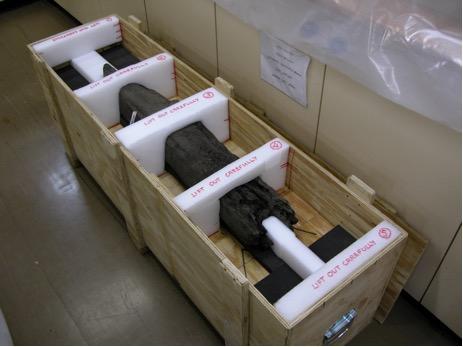Packing for Transportation
It is prudent to assume that objects will be transported and handled without care and to pack accordingly. Request ‘air ride’ truck transport when a more cushioned conveyance is required. Document and photograph objects before packing so that any damage that occurs during transportation will be obvious. Incorporate temperature/relative humidity, shock and/or vibration data loggers in the packaging with extremely valuable objects. If an object is subsequently damaged during transit, the logger record can be used to determine the time of the impact, something that will assist in determining in whose hands the object was when the damage occurred. This will eliminate blame-shifting by identifying whether the damage occurred when it was in the hands of a courier, an airline or while being unpacked at its destination.
Factors to be considered before packing and moving an object include:
- fragility and condition - is the object strong enough to withstand transportation stresses?
- size, weight and value of the object;
- mode of transportation - is an ‘air ride’ truck needed for transport?
- type of container to be used; and
- type of packing materials.
Studies of global transport systems have shown that packed objects are most at risk when being either transported on moveable trolleys (large vibrations on uneven surfaces) or manually handled. Interestingly neither shock nor vibration was found to be significant during take-off or landing when objects were transported by air.
Containers may be made of either metal or wood, depending on the nature of the object to be transported. These materials provide some degree of protection against both shock and environmental changes. Commercially available aluminium transport crates can be fitted out for specific objects. Wooden crates can be custom made, ideally of exterior grade ply, coated inside with water-based polyurethane paint and allowed to off-gas for at least 4 weeks before packing (Figure 15).
Figure 15: Wooden transport crate containing a wooden anchor supported by Cell-Aire® covered Ethafoam™ 220 ‘bridges’ with clear instructions for packing and unpacking (image courtesy Maggie Myers, WA Museum).
Restraining objects is essential if damage is to be prevented from either constant or intermittent vibrations or shock such as when dropped or bumped violently. The size of the container should be such that the object and its packing fit snugly, but not too tightly, inside the container. In this way internal movement is restricted and the risk of damage is reduced.
Materials used in packing for transportation should:
- be resistant to shock;
- provide a buffer against changes in environmental conditions;
- provide a moisture barrier;
- not allow the object to settle to the bottom of the container following packing;
- be chemically inert; and
- be easily distinguishable from the packed object.
Along with the packing materials in the lists above, polystyrene board is also suitable for transportation packing. Polystyrene board is a good insulator and can be used as a liner to minimise temperature fluctuations within a crate. This is particularly relevant for air transportation where the temperature in the cargo hold can drop to -30 °C. Do not use loose polystyrene beads or other loose packing materials which are likely to allow an object to settle through the packing. Polystyrene bean bags are effective as long as they are tightly packed. Closed cell foams such as Bubblewrap™ are preferred to open cell foams like polyurethane foam for crate packing because they are better at preventing water ingress.
Objects for transportation can be wrapped in tissue and then again in Bubblewrap™ or fitted into a 3D cradle within a box so that there is no movement within the box. In the latter case, use shaped Ethafoam™ PE30 to provide object support with the object perhaps also wrapped in tissue or Parasilk, depending on the nature of its surface.
A typical crate packed with fragile objects might comprise the following layers (from the outside moving inwards):
- aluminium or wooden crate;
- lining of Marvelseal® 360 (an aluminium based nylon and polyethylene moisture barrier film), polyethylene sheeting or Mylar™ to waterproof it;
- lining of 30 mm dense polyethylene foam (Ethafoam™ PE30) or polystyrene boards;
- wrapped or boxed object supported in three dimensions;
- silica gel or Art-Sorb® can be incorporated into the packing if relative humidity fluctuations are likely; and
- Ethafoam™ PE30 or rolls of Bubble wrap™ in the spaces between the boxed object and the crate lining to stop any internal movement.
Check List for Packing for Transport:
- Has a method of transportation been decided on?
- Is environmentally controlled transport necessary?
- Have the objects been condition reported and photographed?
- Are the objects well packed with no movement within the crate?
- Have copies of documentation been included within the crate?
- Have environmental and vibration loggers been included if relevant?
- Has the outside of the crate been clearly labelled with the name of the contact person, address and the sender’s details?
- Has the consignment been insured for the transport period?
- Has the transportation itinerary been confirmed?
- Do staff need to escort the consignment to the departure point or even accompany it?
- Has all the information regarding the consignment been sent to all stakeholders?













